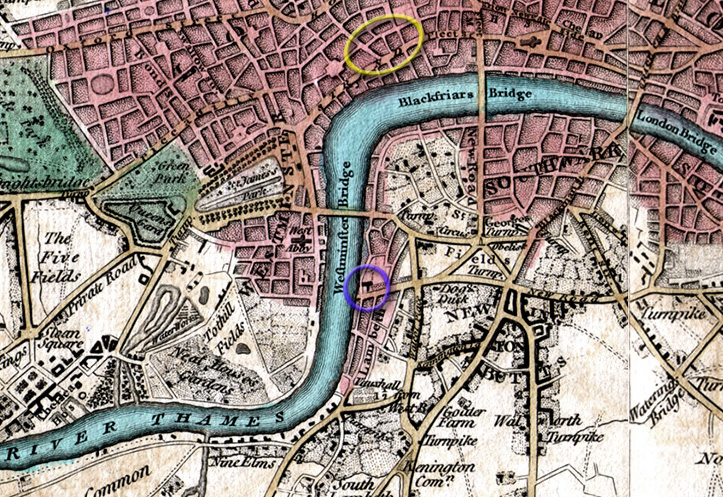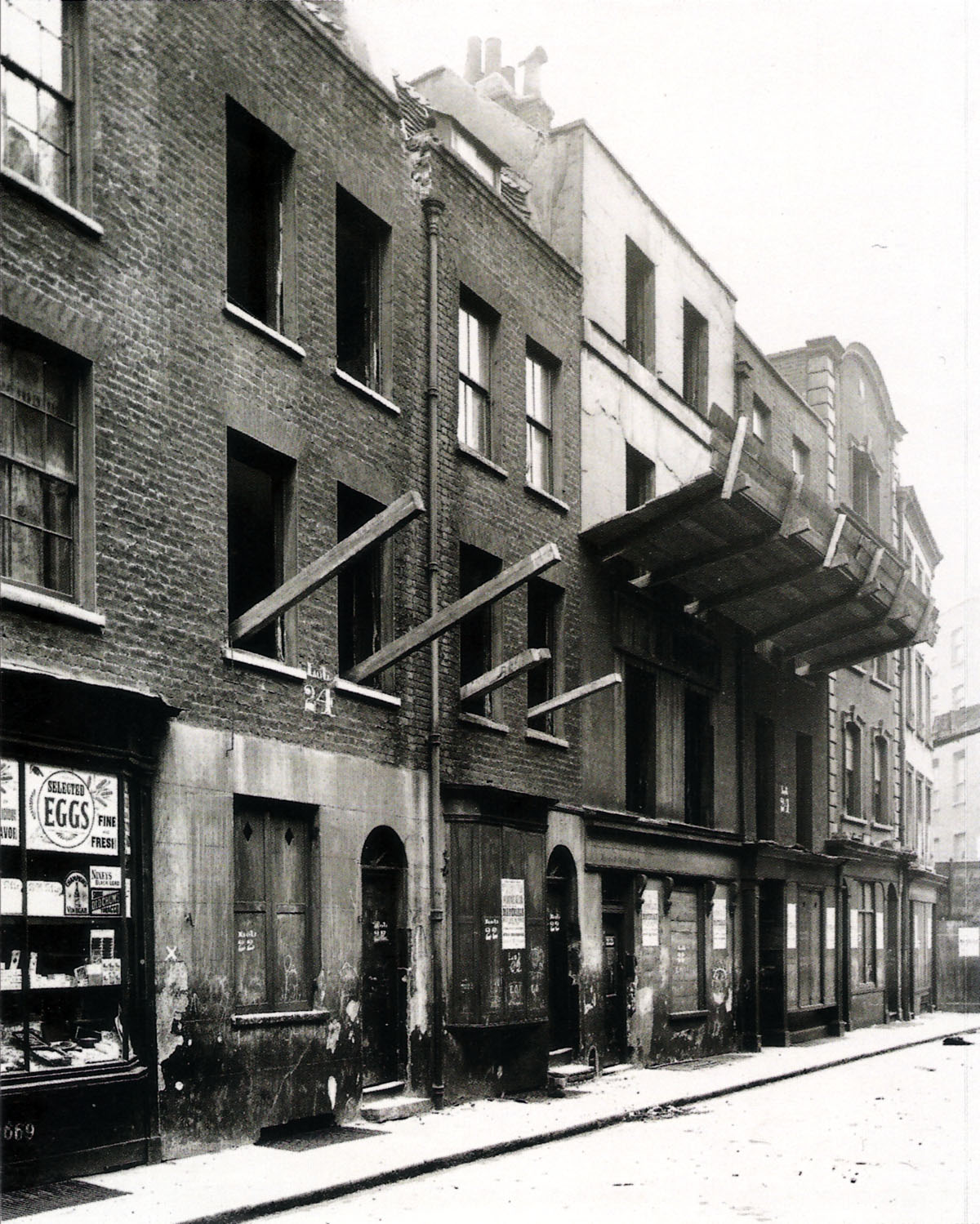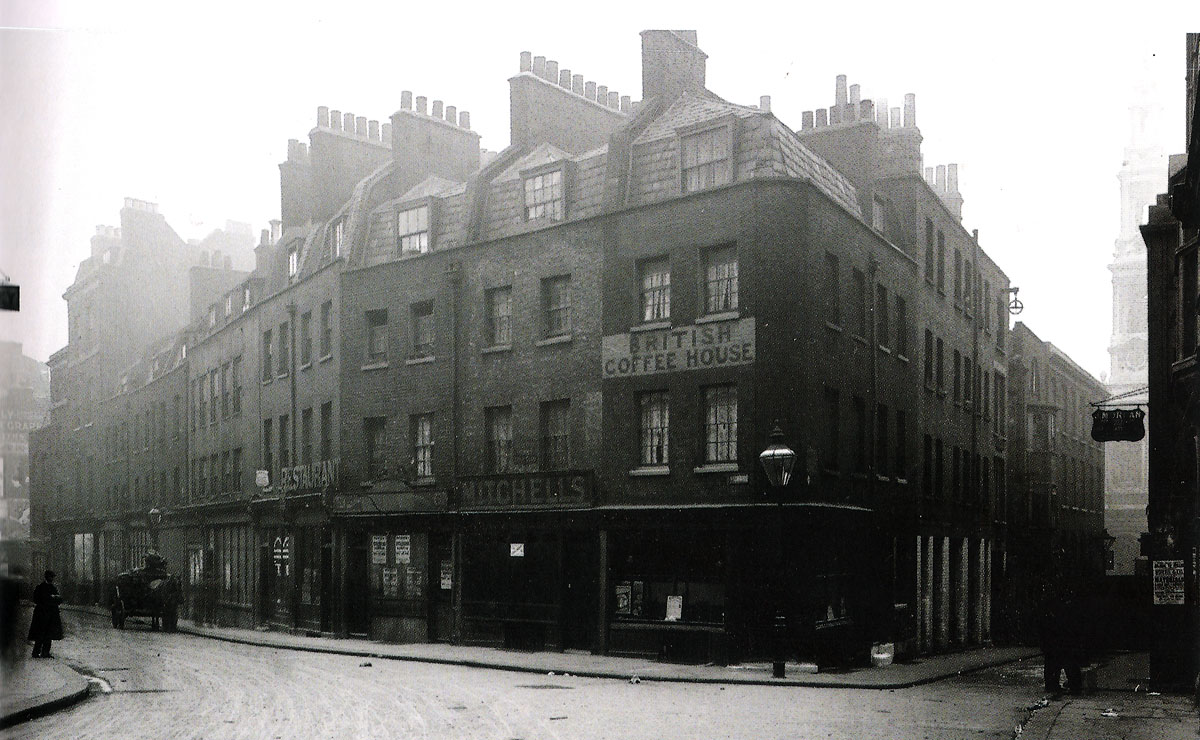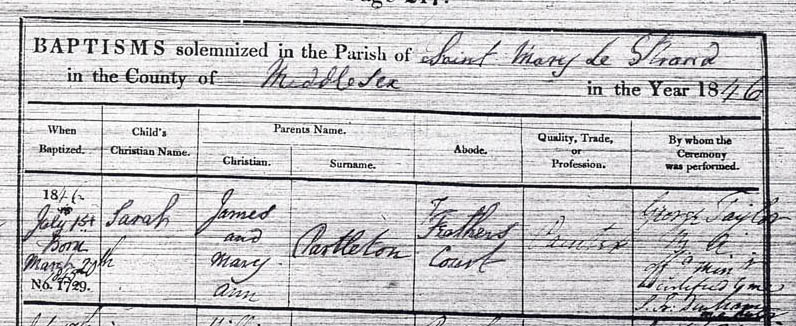


Charles Partleton (1839-1916)
Part I
The birth of Charles Partleton took place, lit by oil lamps or candles, at "5 minutes before three a.m." on the of the morning of Tuesday 12 March 1839.
Here's Charles' birth certificate - he was born ten minutes after his twin brother Benjamin:

Charles' dad was James Partleton (1806-1873), a house painter and former stage performer.
To get our bearings in London, James' birthplace, Houghton Street, near the junction of Drury Lane and The Strand, can be found in the yellow circle in the map below:

We have a picture of the house where Charles was born: 21 Houghton Street. In the photo below, it's the house boarded up on the right, being stripped out for demolition. The photograph, of New Inn Passage, Houghton Street, was taken nearly 70 years after Charles' birth, but we can surmise that he's not born in to a wealthy family.
Far, far from it...

The poster 'Partington' may catch our eye... this was a large advertising firm based at 121 Strand whom one often sees on Victorian billboards. And it is of course complete coincidence, but, as some of our gentle readers may be aware, the name Partleton is possibly an early 18th century variation of the name Partington.
Back to baby Charles; the exact location of his house is outlined blue in the map below... 21 Houghton Street, which is spelled Haughton Street in Richard Horwood's map of 1799:

Ah , but our ability to step into Charles' baby shoes gets better, because though the streets of the neighbourhood of Charles' birth were demolished in the early 20th century, those Edwardians had the foresight to make a permanent photographic record of the houses before they pulled them down. These photos now reside in the archives of English Heritage.
So, let's have a good look at some of them, for they are well worth examinination.
Here's a better photo of New Inn Passage, taken in June 1906:

Charles' house, 21 Houghton Street, is the one next to the corner shop, tantalisingly slipping out of frame on the right. We get just a glimpse of the curtains in the upstairs window.
The above photo was taken from the viewpoint of the blue arrow in the map below:

But we do get a clear view of Charles' house in the next picture, from the yellow arrow, as demolition progresses:

Charles was born in the house marked 24, nearest the camera. Which floor? Well, we can be quite sure that they didn't occupy the whole house; they lived in just one room, but we have no way of telling which one. Incidentally, but don't be fooled by that number 24 painted on the wall. The salvage materials from the demolition of these houses have been auctioned; 24 is the lot number, not the house number.
Baby Charles is a bit young to be looking out of the window, but if he did, here's the view of the pub and the houses on the opposite side of the road:

Did you notice the pair of cats in the doorway?
Some of these houses, on the west side of the street, survived until the 1920s before being demolished. Houghton Street has been home to the London School of Economics since the early 1900s and it has gradually expanded to supplant the entire neighbourhood.
The pub, the Red Lion, is No 4 Houghton Street, and we can see that the above photo was taken from the viewpoint of the dark green arrow in the map below:

And immediately to the north, here's No 8 to No 11 Houghton Street, seen from the brown arrow:

Is that the same black cat again at the friendly shopkeep's ankles?
The sign over his shop, - No 9 Houghton Street - though its paint is flaking, and is rather pixellated in my zoomed-in scan, says 'Gentlemen's Hats Polished for Sixpence'.

And here's the greengrocer's shop on the corner of Houghton Street and Clare Market, photographed on 21 June 1906:

This was Mr John Compton's grocer's shop 65 years earlier, in the 1841 census, so it's fair to say with some certainty that Charles' mum would have bought some vegetables there in 1839. The picture was taken from the viewpoint of the red arrow in the map below:

Finally, for Houghton Street, I photoshopped a montage of two photos, whereby we can see Charles' house, marked by the blue arrow, in the context of the street scene:

That's us done with Houghton Street; Charles won't remember living there: by the time he's two, in the 1841 census, we find him living elsewhere. The family have moved to nearby Feathers Court, an overcrowded, airless, rat-infested, low-rent back-street accessed only by a narrow alleyway; a sink-hole of poor health, crime and poverty, at the point of the sky-blue arrow in the map above. Their neighbours are murderers, drunks, prostitutes, destitutes, pawnbrokers and gin-palace owners. You don't have to take my word for that, just read the terrible stories about Feathers Court in the Partleton Tree web pages for Charles' dad James, his twin brother Benjamin, and his little sister Sarah who was born in 1845.
But in 1841, on 08 May, just a month before the census, Charles gets his first sister, named Mary Ann after her mum.
Below we see the census sheet with the family on it, including some errors made by the enumerator who has mixed up the names and ages, probably confused by the twins. Benjamin should be 2 years old. The new baby, aged just 4 weeks, born into the squalour of Feathers Court, should be Mary Ann. Mary Ann won't live to see another census:

Near to Feathers Court on Drury Lane was a quaint pub, 'The Cock and Magpie', which is great for us because it was a favourite location for Victorian artists to produce paintings in chocolate-box style:

The above painting predates 1866 which is the year when the brewers Combe, Delafield became Combe & Co.
Despite the apparent charm of this painting, we get rather a different impression of this spot - the junction of Drury Lane and Wych Street - in the 1906 photo below. The same corner shop is visible in both images:

These views are seen from the yellow arrow in the map below. The Cock & Magpie pub is shaded yellow. Charles' new home, Feathers Court - the entrance of which is just a few yards behind the cameraman - circled green in the map, is one of the worst slums in London, as we shall discover shortly.

A month after the census, parents James and Mary Anne Partleton decide it is high time they had their children christened. All four baptisms take place on Thursday 01 July 1841 in the church of St Mary-Le-Strand, circled in red in the map above.

Above we see the baptism of our Charles aged 4, his twin brother Benjamin, his older brother James and his new little baby sister Mary Ann. The ceremony took place in the church of St Mary-Le-Strand, seen below:

The painting above was created in the late 18th century by artist Thomas Malton, many years before our Charles was born, but his viewpoint in The Strand, from the point of the pink arrow in the map below, would be entirely familiar to our Charles. It's only much later that the area was radically changed, with the creation of The Aldwych in the early 1900s.

The next painting is contemporaneous with Charles' time, painted by artist George (Sydney) Shepherd, observing some road repairs in Holywell Street with St Mary-Le-Strand in the background.
OK, you will realise I'm running out of colours for my arrows when I tell you that the picture is painted from the viewpoint of the khaki arrow in the map above:

Moving on, in 1845 Charles gained a sister, Sarah, and lost one, Mary Ann.
Mary Ann had lived just four years. In September 1845, a wave of tuberculosis swept through Feathers Court, killing at least five children, one of them Mary Ann Partleton:

Search Google Books for Feathers Court and you will find lots of references to it. Nearly all of them describing someone's premature agonising death. People were dying at Feathers Court of terrible diseases for decades. Below we see two widely separated examples of death by disease at the exact building where Charles is living - No.7 Feathers Court:
1829:


...you'll have to take my word for it; this story gets much, much worse before the poor woman dies so I'll spare the further details. You can find this book in Google Books.
The next example is very illuminating because it identifies the exact size of the rooms at 7 Feathers Court: rooms identical to that in which Charles grew up with his mum and dad and three siblings. 17 feet by 17 feet. That's your lot. No other rooms. One window. Primitive cooking facilities in the same room. Beds and other furniture somehow crammed in to the same space. A toilet in the yard shared with all the other houses in the court, draining only into a cesspit. No wonder they died.
1858:
From 'Lectures on Pathological Anatomy at Guy's Hospital', Samuel Wilks 1858:

In a later book about theatres, we find Feathers Court gets a mention - again an unflattering one:

So, let's have a look at what Feathers Court looked like:

In the above photo we stand in Charles' young shoes - though he may not have possessed any - take a walk outside his front door in Feathers Court, and look eastwards towards Drury lane from the viewpoint of the sky blue arrow in the map below.
OK, the picture was taken in 1906, which is why we see demolition in progress and the arched entrance to the court covered with a temporary wooden gate, but it is quite amazing that posterity has preserved for us an image of this place.

Before we progress further, let's go for a walk around young Charles' insalubrious neighbourhood. The first picture is Angel Court, on a rainy day in 1906, seen from the point of the orange arrow in the map above:

The next slum is Helmet Court:

In the photo above, we are looking back towards The Strand. The entranceway to Helmet Court is through the arch at the end of the courtyard. We are looking from the viewpoint of the purple arrow in the map below:

Lastly, from the turquoise arrow in the map, we see the bleak interior of Windsor Court:

All of these dark courts were swept away with the creation of The Aldwych in the early 20th century.
In July 1846 we see the christening of Charles' sister Sarah at St Mary-Le-Strand:

This is the last record for the Partleton family at Feathers Court; they are moving house, but if we are hoping that they are perhaps moving somewhere nice, then we are going to be disappointed.
During late 1846 or early 1847, Charles' mum & dad move south of the river to Lambeth, circled blue in the map below, where most of the rest of the Partleton family have already migrated over the previous 30 years.

Click here to continue with the story of Charles Partleton (1839-1916).
If you enjoyed reading this page, you are invited to 'Like' us on Facebook. Or click on the Twitter button and follow us, and we'll let you know whenever a new page is added to the Partleton Tree:
Do YOU know any more to add to this web page?... or would you like to discuss any of the history... or if you have any observations or comments... all information is always welcome so why not send us an email to partleton@yahoo.co.uk
Click here to return to the Partleton Tree 'In Their Shoes' Page.
